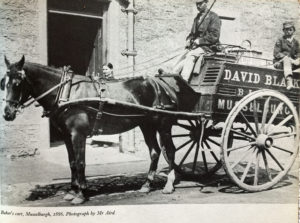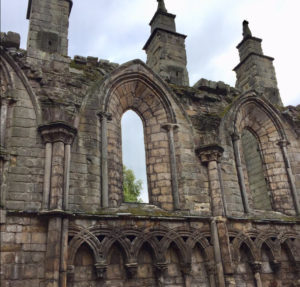John Black b 1558 and Elizabeth Bessie Locart b 1568
John Black was born in 1558 in Canongate, Midlothian, Scotland. He died in 1650 in Edinburgh Castle, Midlothian, Scotland. John married Elizabeth Bessie Locart.
Elizabeth Bessie Locart was born in 1568 in Clalore, Middle Lothian, Scotland. She died in 1641 in Canongate, Edinburgh, Scotland.
The Canongate is a district of central Edinburgh, the capital city of Scotland. It forms the eastern section of Edinburgh’s Old Town. It began as a separate burgh, founded by David I of Scotland around 1143. It was absorbed by the adjacent city of Edinburgh in 1636. Until then, the Holyrood Abby was the parish church of the Canongate where our Black ancestors worshiped. The present Canongate Kirk (church), opened in 1691 replacing Holyrood Abbey as the parish church of the Canongate.
There are many unknowns about the Black family. There are family lines that originate in both Scotland and England. What we do know is that our line of the Black family originated in the Highlands of Scotland hundreds of years ago. If you could turn back the clock and visit the area in those early days you would not find anyone by the name of Black. Instead, everyone went by the name of Lamont. In our family line, the first evidence is found in a letter from a Laird of the Lamont Clan in Scotland responding to a letter written by John Black in Belfast, Ireland in 1723, inquiring about information regarding his Scottish heritage for his son. The Laird states:
“You tell me your son, who has the honor of being his Majesty King Georges consul at Cadiz, wants to know when the BLACKs descended form the family I represent, and how they came to have their mane changed from lamont to that under which they now go; in compliance to which reasonable request, please take an account of both as follows:–Lamont had a son about 400 or 500 years ago, whose hair, as we have it handed down by tradition, was very black, on which account he was called a Ghiolle dugh, which in English the Black Lad; his son, again, was called Mac a Ghiolle dugh, in English the Black Lads Son, and so was his posterity ever since called with us, of whom there is a pretty good number in Cowhall, and in other parts of the Highlands; but such of them as went to the Lowlands, England, Ireland, or other kingdoms, called themselves BLACKs, being a literal translation of dugh into English. And this branch of the family of Lamont were so very zealous and careful to preserve its memory.”
The first evidence of the name Black in Scotland is found in the 1400 and 1500 hundreds. This is about the time our family line began the migration from the Highlands down to the more populated lowlands of Scotland. Early records show that many Blacks migrated to Edinburgh, Scotland, which in those days was the cultural center of Scotland It was where the Scottish Royalty lived and the center of government. Formal records of our family line begin to show up in the 1500 hundreds. Records show the Blacks were not farmers but Townspeople, such as, tailors, builders, merchants, politicians, clerks, etc. Many Blacks became prominent as Lord Provost, Abbot, etc.
This was at the time of the reign of King James VI, son of Mary Queen of Scots, when the kingdoms of Scotland and England were individual sovereign states, with their own parliaments, judiciary, and laws, although both were ruled by King James.
In the 16th century, across the Irish Sea channel from Scotland, the English were seeking to extend their control over Ireland. One of the ways they tried to do this was to drive the Catholic Irish landowners off their land and replace them with Protestant English or Scottish settlers. Between the 1550’s and the 1650’s. This process was called a “Plantation.”
Letter Written by John Black 1723 to the Laird of Scottish Clan Lamont
History of the Scottish Clan Lamont
John Black – First Scottish Black into Ireland

